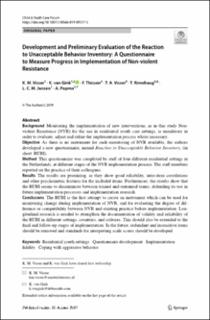| dc.contributor.author | Visser, Katharina M | |
| dc.contributor.author | van Gink, Kirsten | |
| dc.contributor.author | Thissen, Floor | |
| dc.contributor.author | Visser, TA | |
| dc.contributor.author | Rimehaug, Tormod | |
| dc.contributor.author | Jansen, Lucres CM | |
| dc.contributor.author | Popma, Arne | |
| dc.date.accessioned | 2021-01-13T09:33:23Z | |
| dc.date.available | 2021-01-13T09:33:23Z | |
| dc.date.created | 2019-10-10T11:09:26Z | |
| dc.date.issued | 2019 | |
| dc.identifier.citation | Child and Youth Care Forum. 2019, 49 (1), 43-57. | en_US |
| dc.identifier.issn | 1053-1890 | |
| dc.identifier.uri | https://hdl.handle.net/11250/2722719 | |
| dc.description.abstract | Background Monitoring the implementation of new interventions, as in this study Nonviolent Resistance (NVR) for the use in residential youth care settings, is mandatory in order to evaluate, adjust and refne the implementation process where necessary. Objective As there is no instrument for such monitoring of NVR available, the authors developed a new questionnaire, named Reaction to Unacceptable Behavior Inventory, (in short: RUBI). Method This questionnaire was completed by staf of four diferent residential settings in the Netherlands, at diferent stages of the NVR implementation process. The staf members reported on the practice of their colleagues. Results The results are promising, as they show good reliability, inter-item correlations and other psychometric features for the included items. Furthermore, the results show that the RUBI seems to discriminate between trained and untrained teams, defending its use in future implementation processes and implementation research. Conclusions The RUBI is the frst attempt to create an instrument which can be used for monitoring change during implementation of NVR, and for evaluating the degree of difference or compatibility between NVR and existing practice before implementation. Longitudinal research is needed to strengthen the documentation of validity and reliability of the RUBI in diferent settings, countries, and cultures. This should also be extended to the fnal and follow-up stages of implementation. In the future, redundant and insensitive items should be removed and standards for interpreting scale scores should be developed. | en_US |
| dc.language.iso | eng | en_US |
| dc.publisher | Springer | en_US |
| dc.rights | Navngivelse 4.0 Internasjonal | * |
| dc.rights.uri | http://creativecommons.org/licenses/by/4.0/deed.no | * |
| dc.title | Development and Preliminary Evaluation of the Reaction to Unacceptable Behavior Inventory: A Questionnaire to Measure Progress in Implementation of Non-violent Resistance | en_US |
| dc.type | Peer reviewed | en_US |
| dc.type | Journal article | en_US |
| dc.description.version | publishedVersion | en_US |
| dc.source.pagenumber | 43-57 | en_US |
| dc.source.volume | 49 | en_US |
| dc.source.journal | Child and Youth Care Forum | en_US |
| dc.source.issue | 1 | en_US |
| dc.identifier.doi | 10.1007/s10566-019-09517-5 | |
| dc.identifier.cristin | 1735857 | |
| dc.description.localcode | © The Author(s) 2019. This article is distributed under the terms of the Creative Commons Attribution 4.0 International License (http://creativecommons.org/licenses/by/4.0/), which permits unrestricted use, distribution, and reproduction in any medium, provided you give appropriate credit to the original author(s) and the source, provide a link to the Creative Commons license, and indicate if changes were made. | en_US |
| cristin.ispublished | true | |
| cristin.fulltext | original | |
| cristin.qualitycode | 1 | |

